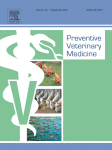Ver ítem
- xmlui.general.dspace_homeCentros Regionales y EEAsCentro Regional Santa FeEEA RafaelaArtículos científicosxmlui.ArtifactBrowser.ItemViewer.trail
- Inicio
- Centros Regionales y EEAs
- Centro Regional Santa Fe
- EEA Rafaela
- Artículos científicos
- Ver ítem
Risk factors associated with the presence of Varroa destructor in honey bee colonies from east-central Argentina
Resumen
Varroa destructor is considered one of the major threats for worldwide apiculture. Damage caused by varroa mite includes body weight loss, malformation and weakening of the bees. It was also suggested as the main cause associated with colony winter mortality and as an important vector for several honey bee viruses. Little is known about multiple factors and their interaction affecting V. destructor prevalence in apiaries from South America. The aim of
[ver mas...]
Varroa destructor is considered one of the major threats for worldwide apiculture. Damage caused by varroa mite includes body weight loss, malformation and weakening of the bees. It was also suggested as the main cause associated with colony winter mortality and as an important vector for several honey bee viruses. Little is known about multiple factors and their interaction affecting V. destructor prevalence in apiaries from South America. The aim of this study was to identify risk factors associated with V. destructor prevalence in east-central Argentina. Parasitic mite infestation level and colony strength measures were evaluated in 63 apiaries distributed in 4 different regions in east-central Argentina in a cross sectional study. Data regarding management practices in each apiary were collected by means of a questionnaire. A mixed-effects logistic regression model was constructed to associate management variables with the risk of achieving mite infestation higher than 3%. Colonies owned by beekeepers who indicated that they did not monitor colonies after mite treatment (OR = 2.305; 95% CI: 0.944–5.629) nor disinfect hives woodenware material (OR = 2.722; 95% CI: 1.380–5.565) were associated with an increased risk of presenting high intensity infestation with V. destructor (>3%). On the other hand, beekeepers who reported replacing more than 50% of the queens in their operation (OR = 0.305; 95% CI: 0.107–0.872), feeding colonies protein substitute containing natural pollen (OR = 0.348; 95% CI: 0.129–0.941) and feeding colonies High Fructose Corn Syrup (HFCS) (OR = 0.108; 95% CI: 0.032–0.364), had colonies that were less likely to have V. destructor infestations above 3%, than beekeepers who did not report using these management practices. Further research should be conducted considering that certain management practices were associated to mite infestation level in order to improve the sanitary condition in the colonies. Epidemiological studies provide key information to design surveillance programs against one the major threat to worldwide beekeeping.
[Cerrar]

Fuente
Preventive Veterinary Medicine 115 (3–4) : 280-287 (August 2014)
Fecha
2014-08-01
ISSN
0167-5877
Formato
pdf
Tipo de documento
artículo
Palabras Claves
Derechos de acceso
Restringido
 Excepto donde se diga explicitamente, este item se publica bajo la siguiente descripción: Creative Commons Attribution-NonCommercial-ShareAlike 2.5 Unported (CC BY-NC-SA 2.5)
Excepto donde se diga explicitamente, este item se publica bajo la siguiente descripción: Creative Commons Attribution-NonCommercial-ShareAlike 2.5 Unported (CC BY-NC-SA 2.5)

